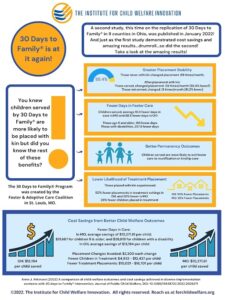30 Days to Family®: Evidence and Outcomes
In January 2022, a second comparison study on the outcomes and cost savings of 30 Days to Family® was published in the Journal of Public Child Welfare! This study compared the results of the program in Missouri to the implementation in 9 geographically dispersed counties throughout the state of Ohio. Just as we anticipated, the data showed the outcomes and cost savings were achieved in Ohio just as in Missouri!
Check out the journal article here, as well as our infographic below!
30 Days to Family® Outcomes*:
Missouri:
- More Likely to be Placed with Kin:
- Significantly higher percentages of children served by 30 Days to Family® were placed with kin than those who weren’t.
- Less Time in Care:
- Children served by 30 Days to Family® remained in foster care an average 91.4 fewer days.
- Those age 9 years and older were in care an average 194 fewer days.
- Those with an identified disability were in care an average 257.8 fewer days.
- Increased Placement Stability:
- For children served by 30 Days to Family®, placement change rates were reduced by 81% after being placed with kin.
- Reduced Treatment Placements:
- 28.3% fewer children experienced placement in treatment settings when served by 30 Days to Family®.
- Those youth placed with kin had 38% fewer treatment placements.
Ohio:
- More likely to be placed with kin and more likely to exit to live with kin.
- More likely to exit care to live with kin.
- Less Time in Care:
- Children served by 30 Days to Family® remained in foster care an average 68.5 fewer days.
- Increased Placement Stability:
- For children served by 30 Days to Family®, placement change rates were reduced by 36% after being placed with kin.
- Reduced Treatment Placements.
- 50% fewer placements in treatment environments for children placed with kin.
*Atkinson, A.J. (2019). 30 Days to Family®: Confirming Theoretical and Actual Outcomes. Child Welfare, 97(4), 97-129.
*Atkinson, A.J. (2022). A Comparison of Child Welfare Outcomes and Cost Savings Achieved in Diverse Implementation Contexts with 30 Days to Family® Intervention. Journal of Public Child Welfare. DOI:10.1080/15548732.2022.2026271
30 Days to Family® Cost Savings*:
Missouri:
- Children Exiting Sooner:
- Every child served by 30 Days to Family® saves taxpayers an average of $10,217.
- Every child served age 9 years and older saves taxpayers an average of $21,686.
- Every child served who has an identified disability saves taxpayers an average of $28,819.
- Placement Stability:
- Minimum $2,300 savings in direct, child welfare agency costs per placement change avoided
- Reduced Treatment Placement:
- Minimum $2,416 per month/$29,000 per child per treatment placement avoided.
- Avoiding Re-Entry:
- Minimum $110.42 per day per child per re-entry to foster care avoided. No children served experienced re-entry in the last year of study; whereas, 26 in the comparison group not served did.
Ohio:
- Children Exiting Sooner:
- Every child served by 30 Days to Family® saves taxpayers an average of $13,194.
- Increased Placement Stability:
- Minimum $2,300 savings in direct, child welfare agency costs per placement change avoided.
- Reduced Treatment Placement:
- Based on the cost of $7,348 for a three-month placement in a treatment setting, the cost of ten children experiencing such placements would be $73,480. If only five children rather than ten experience the placement, the cost savings would be $36,240.
*Atkinson, A.J. (2019). 30 Days to Family®: Confirming Theoretical and Actual Outcomes. Child Welfare, 97(4), 97-129.
*Atkinson, A.J. (2022). A Comparison of Child Welfare Outcomes and Cost Savings Achieved in Diverse Implementation Contexts with 30 Days to Family® Intervention. Journal of Public Child Welfare. DOI:10.1080/15548732.2022.2026271
30 Days to Family® Placement & Stability Data from the Site of Origin:
The Foster & Adoptive Care Coalition’s 30 Days to Family® team in St. Louis, MO is pretty cool. Don’t take our word for it – the numbers speak for themselves!
In reviewing data from the St. Louis 30 Days to Family® site from the beginning of the program in February 2011 through July 2022:
- Placement Rate: 868 of 1134 (76.5%) children served were placed with family at the conclusion of services
- The program goal is to achieve a 70% placement rate, but who doesn’t love an overachiever?
- Placement Stability: Of those 868 children placed with family, follow ups have been conducted for 842 of them and confirmed that 691 (82.1%) remained placed with family at the most recent follow-up
- 605 children (71.9%) remained in their initial family placement or returned home!
- 86 children (10.2%) remained with family, but moved to the home of another family placement option
- Promoting Family Placement: Sometimes despite best efforts, children aren’t moved with family during the program intervention. The remarkable thing is that the work done was not for nothing. 77 of the 264 children (29.2%) that were not placed with family at the conclusion of services had achieved family placement at the time of the most recent follow-up!
- 12 of the 77 (15.6%) were placed with the family member identified during the 30 Days to Family® intervention
- 12 of the 77 (15.6%) were placed with another family member
- 53 of the 77 (68.8%) returned home!
Clearinghouse Details
30 Days to Family® is rated in the California Evidence Based Clearinghouse (CEBC) . 30 Days to Family® is listed in the CEBC as a program rated as “Promising Research Evidence.” In addition, the program was designated as having “High Child Welfare System Relevance.” Further validating what we already knew about the benefits of the model, including getting children out of the system more quickly, the program was accepted to the CEBC under the topic area of “Permanency Enhancement Interventions for Adolescents.”
We couldn’t be more proud and excited to have met this tremendous milestone and can’t wait for this opportunity to help bring 30 Days to Family® to more children and families throughout the country.
The 30 Days to Family® CEBC information can be accessed here.
We remain in active communication with the Title IV- E Prevention Services Clearinghouse. We submitted for review in October of 2019 and are awaiting a determination.

